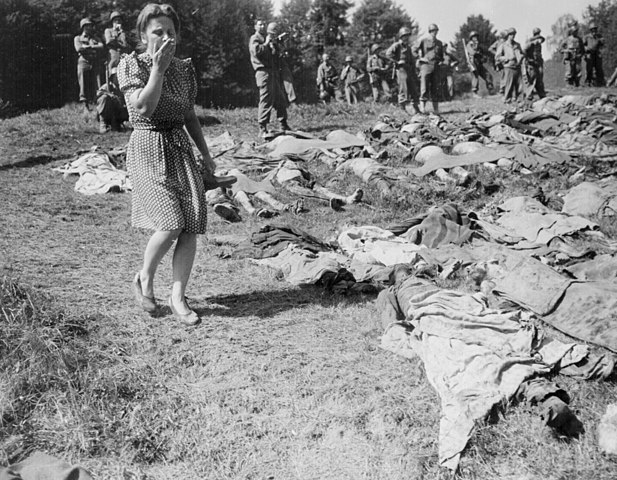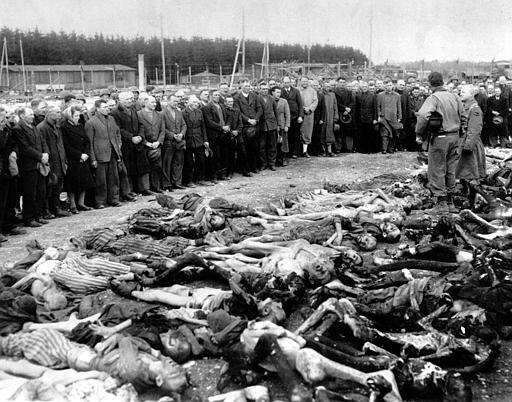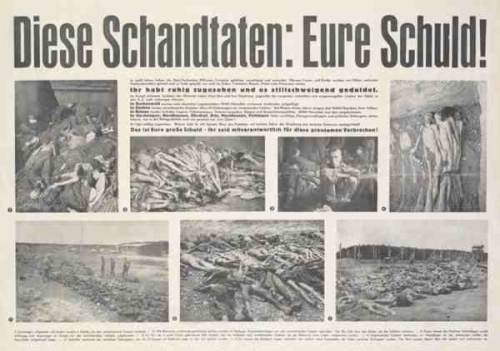The end of denazification
As denazification was deemed ineffective and counterproductive
by the Americans, the Allied propaganda changed its methods.
Collective guilt campaign


Allied troops commonly forced German civilians at gun point to
tour concentration camps and in some cases to exhume mass graves
of Nazi victims.

Diese Schandtaten: Eure Schuld! ("These atrocities: Your
Fault!") One of
the posters distributed by U.S. occupation
authorities in the summer of
1945 for the purpose of instilling
a sense of collective guilt.[20]
In 1969 Time
Magazine stated
that
In 1945 there was an Allied consensus—which
no longer exists—on the doctrine of collective guilt, that
all Germans shared the blame not
only for the war but for Nazi atrocities as
well.[21][22]
The ideas of collective
guilt and collective
punishment originated
not with the US and British people, but on higher policy levels.[23] Not
until late in the war did the U.S. public assign collective
responsibility to the German people.[23] The
most notable policy document containing elements of collective
guilt and collective punishment is JCS
1067 from
early 1945.[23] Eventually horrific
footage from the concentration camps would serve to harden
public opinion and bring it more in line with that of
policymakers.[23]
Already in 1944 prominent U.S. opinion makers had initiated a
domestic propaganda campaign (which was to continue until 1948)
arguing for a harsh peace for Germany, with a particular aim to
end the apparent habit in the U.S. of viewing the Nazis and the
German people as separate entities.[24]
Statements made by the British and U.S. governments, both before
and immediately after Germany's surrender,
indicate that the German nation as a whole was
to be held responsible for the actions of the Nazi regime, often
using the terms "collective guilt" and "collective
responsibility".[25]
To that end, as
the Allies began their post-war denazification efforts, the Psychological
Warfare Division (PWD) of SHAEF (Supreme
Headquarters Allied Expeditionary Force) undertook a
psychological propaganda campaign for the
purpose of developing a German sense of collective
responsibility.[26]The
Public Relations and Information Services Control Group of
the British Element of the Allied Control Commission began
in 1945 to issue directives to
officers in charge of producing newspapers and radio broadcasts
for the German population to emphasize "the
moral responsibility of all Germans for Nazi crimes."[27] Similarly,
among U.S. authorities, such
a sense of collective guilt was "considered a prerequisite
to any long-term education of the German people."[26]
Using the German press, which was under Allied control, as well
as posters and pamphlets, a program was conducted to acquaint
ordinary Germans with what had taken place in the concentration
camps. For example using posters with images of concentration
camp victims coupled to text such as "YOU
ARE GUILTY OF THIS!"[28][29] or
"These
atrocities: Your Guilt!!"[30] A number
of films showing the concentration camps were
made and screened to the German public, such
as "Die
Todesmühlen",
released in the U.S. zone in January 1946, and "Welt
im Film No. 5"
in June 1945. A
film that
was never finished due partly to delays and the existence of the
other films was "Memory
of the Camps". According
to Sidney Bernstein, chief of PWD, the
object of the film
...was to shake and
humiliate the Germans and prove
to them beyond any possible challenge that these German
crimes against humanity were committed and that the German
people – and not just the Nazis and SS – bore
responsibility.[31]
frontline -memory of the camps- watch
the full program online - PBS.mp4 - YouTube
English writer James
Stern recounted
an example in a German town soon after the German surrender.
"[a] crowd
is gathered around a series of photographs which though
initially seeming to depict garbage instead reveal dead human
bodies. Each photograph has a heading 'WHO IS GUILTY?'. The
spectators are silent, appearing hypnotised and eventually
retreat one by one. The placards are later replaced with clearer
photographs and placards proclaiming 'THIS TOWN IS GUILTY! YOU
ARE GUILTY!'"[32]On
July 20, 1945 — the first anniversary of the failed attempt to
kill Hitler — no mention whatsoever was made of the event. This
was because reminding
the German population of the fact that there had been active
German resistance to Hitler would have undermined the Allied
effort to instill a sense of collective guilt in the German
populace.[33]
Immediately upon the liberation of the concentration camps many
German civilians were forced to see the conditions in the camps,
bury rotting corpses and exhume mass
graves.[34] On
threat of death or withdrawal of food, civilians
were also forced to provide their belongings to former
concentration camp inmates.[34]
http://en.wikipedia.org/wiki/Denazification
"When a Jew, in America or in South Africa, talks to
his Jewish companions about 'our' government, he means the
government of Israel."
- David Ben-Gurion, Israeli Prime Minister

Viva Palestina!
Latest Additions
- in English
What is this Jewish
carnage
really about? - The background to
atrocities
Videos on Farrakhan, the Nation of Islam and Blacks and Jews

How Jewish Films and Television Promotes bias Against
Muslims
Judaism is Nobody's
Friend
Judaism is the Jews' strategy to
dominate non-Jews.
Jewish War Against
Lebanon!
Islam and Revolution
By Ahmed Rami
Hasbara -
The Jewish manual
for media deceptions
Celebrities bowing to their Jewish masters

Elie Wiesel - A Prominent False Witness
By Robert Faurisson
The Gaza atrocity 2008-2009

Iraq - war and occupation
Jewish War On
Syria!
CNN's Jewish version of "diversity"
- Lists the main Jewish agents
Hezbollah the Beautiful
Americans, where is your own Hezbollah?
Black Muslim leader Louis Farrakhan's Epic Speech in Madison Square
Garden, New York
 - A must see!
- A must see!
"War on Terror" -
on Israel's behalf!
World Jewish Congress: Billionaires, Oligarchs, Global Influencers for Israel
Interview with anti-Zionist veteran Ahmed Rami of Radio Islam
- On ISIS, "Neo-Nazis", Syria, Judaism, Islam, Russia...
Britain under Jewish
occupation!

Jewish World Power
West Europe
East Europe
Americas
Asia
Middle East
Africa
U.N.
E.U.
The Internet and
Israeli-Jewish infiltration/manipulations
Books
- Important collection of titles
The Judaization of
China
Israel: Jewish Supremacy in Action
- By David Duke
The Power of Jews in France
Jew Goldstone appointed by UN to investigate War Crimes in Gaza

The best book on Jewish Power
The Israel Lobby
- From the book
Jews and Crime - The archive
Sayanim - Israel's and Mossad's Jewish helpers abroad
Listen to Louis Farrakhan's Speech
- A must hear!
The Israeli Nuclear Threat
The "Six
Million" Myth
"Jewish History"
- a bookreview
Putin and the
Jews of Russia
Israel's attack on US warship USS Liberty
- Massacre in the Mediterranean
Jewish "Religion" - What is
it?
Medias
in the hands of racists
Strauss-Kahn - IMF chief and member of Israel lobby group

Stop Jewish Apartheid!
The Jews behind Islamophobia
Israel controls U.S. Presidents
Biden, Trump, Obama, Bush, Clinton...
The Victories of Revisionism
By Professor Robert Faurisson
The Jewish hand behind Internet
The Jews behind Google, Facebook, Wikipedia,
Yahoo!, MySpace, eBay...
"Jews, who want to be decent human beings, have to renounce being Jewish"
Jewish War Against Iran
Jewish Manipulation of World Leaders

Al Jazeera English under
Jewish infiltration

Garaudy's "The Founding
Myths
of Israeli Politics"
Jewish hate against Christians
By Prof. Israel Shahak
Introduction to Revisionist
Thought
- By Ernst Zündel
Karl Marx: The Jewish Question
Reel Bad Arabs
- Revealing the racist Jewish Hollywood propaganda
"Anti-Semitism" - What is it?
Videos
 - Important collection
- Important collection
The Jews Banished 47 Times in 1000 Years - Why?
Zionist
strategies
- Plotting invasions, formenting civil wars, interreligious strife,
stoking racial hatreds and race war
The International Jew
By Henry Ford
Pravda interviews Ahmed Rami

Shahak's
"Jewish History,
Jewish Religion"
The Jewish plan to destroy the Arab countries
- From the World Zionist Organization
Judaism and Zionism inseparable
Revealing photos of the Jews 
Horrors of ISIS Created by Zionist Supremacy
- By David Duke
Racist Jewish Fundamentalism
The Freedom Fighters:
 Hezbollah
- Lebanon
Hezbollah
- Lebanon
 Nation of Islam
- U.S.A.
Nation of Islam
- U.S.A.
Jewish Influence in America

- Government, Media, Finance...
"Jews" from
Khazaria stealing the land of Palestine
The U.S. cost of supporting Israel
Turkey, Ataturk and
the Jews

The truth about the Talmud
Israel and the Ongoing Holocaust in Congo
Jews DO control the media -
a Jew brags!
- Revealing Jewish article
Abbas - The Traitor
Protocols of Zion
- The whole book!

Encyclopedia of the
Palestine Problem
The
"Holocaust" - 120 Questions and Answers
Quotes
- On Jewish Power / Zionism
Caricatures / Cartoons

Activism!
- Join the Fight!





































